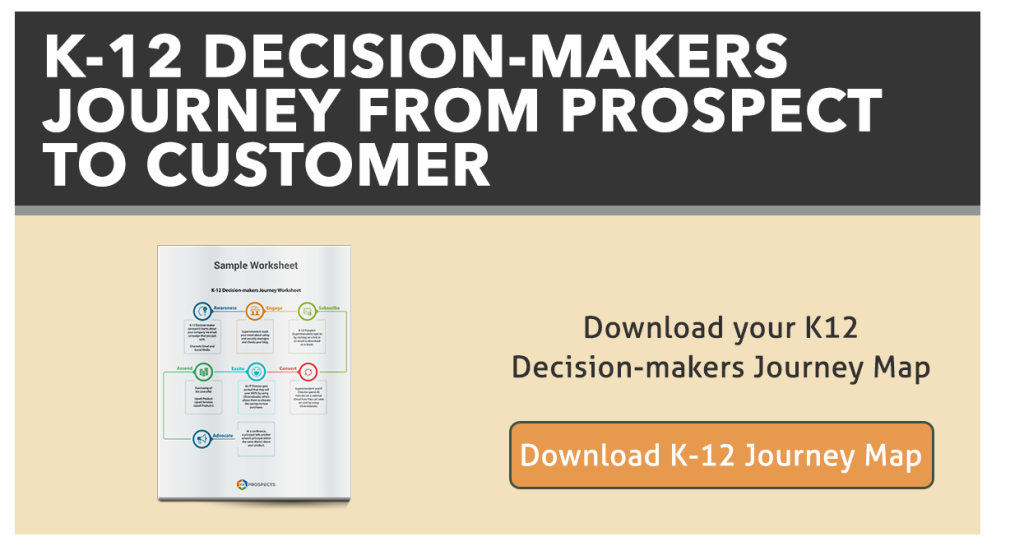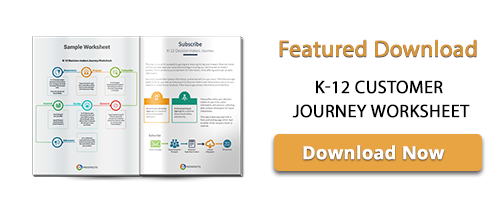K-12 Decision-makers Journey from Prospect to Customer
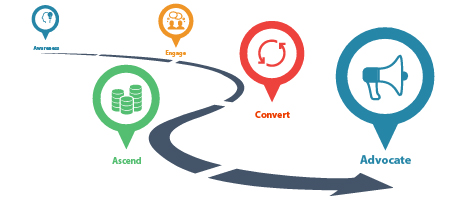
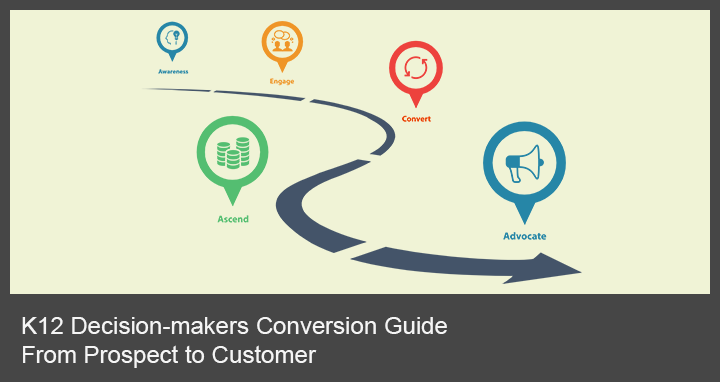
When you’re looking to convert new prospects into a long time K12 buyers, your work starts and ends with your decision-maker buyer’s journey. The process begins with leads which you will convert into customers and, following your proven strategy, loyal return clients. This is not a one-stop solution to simply sell a product to K12 buyers. Instead, it is a long-term plan which can develop your business into a sustained success.
You will develop a solid client relationship, providing guidance and value before selling a product. This strategy will allow you to become a valued part of your K-12 buyer’s world. Remember that focusing on quick sales will not yield long-term returns. The following steps are vital to developing a repertoire with your K-12 decision-makers.
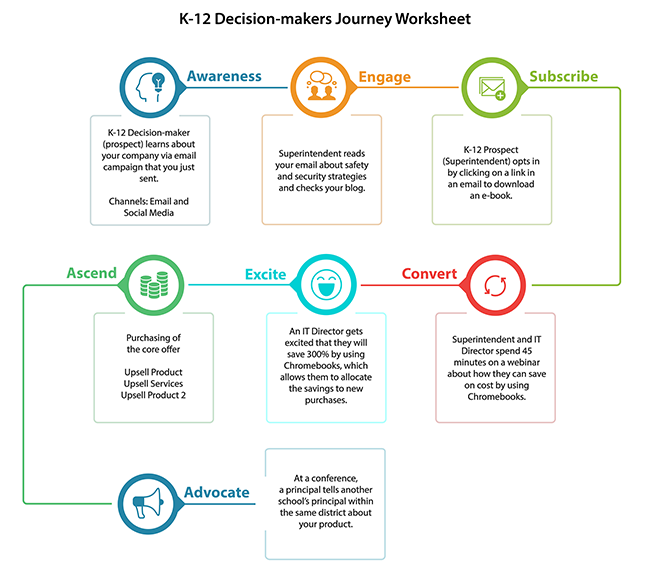
In just a second we will explain how to create your customer journey map.
By the end, you will have a downloadable template for the K-12 decision-makers journey map.
Awareness
Your first step is to create awareness about your company, products and the value you can add to your potential client. You can do this by providing a solution to a problem which your lead is tackling. This problem can be something your K-12 decision-maker is actively looking to combat or an underlying issue they may be unaware of.
In this step, you do not attempt to sell products or give a sales pitch to your leads. Instead, you are building value for your company by providing insightful content or other helpful directives.
These examples are ideal for your average K12 decision-maker.
A School principal receives an email from a company about how to resolve student dismissal chaos.
A Superintendent gets an email from a company teaching them safety and security strategies.
An IT director forwards an email to a colleague in the same district about new tablet charging and storage boxes.
Email advertising is the ideal way to create awareness for your potential K12 decision-makers. This strategy is affordable and time-conscious.

Engage
Once your potential K12 decision-makers are aware of your existence and possible value, you want to engage them. You do this by providing content or information which provides even more value.
The following examples of engaging content are great for your K12 decision-makers.
A Curriculum coordinator receives a newsletter about digital curriculum games that engage kids to think out of the box.
A Superintendent clicks on a link in an email to download an e-book about professional development for his staff.
A District accounting director reads the subject line Bad Check Collection Just for Schools, about how to retrieve bounced check funds for student meals.
The following graphic displays how this step should progress.

Subscribe
This step is crucial for successfully gaining and retaining K12 decision-makers. Potential clients will have already seen your value and have begun trusting your ability to deliver helpful content. This trust allows you to ask them for information while offering continued valuable information.
You must request their contact information so that the ball is in your court. The follow through needs to be on your end, as many busy K12 decision-makers won’t have time to return to your website or research your products.
A few ways to get contact information are listed here.
A School principal signs up for a webinar about school safety and security.
A Curriculum director signs up for a demo of a new assessment software.
These offers allow your decision-makers to opt-in for useful information and services, collecting their contact information for future interactions.
This step is best executed with a form and landing page which lead to either a free sample, Ebook or webinar.

Convert
At this stage, you are building continued trust with your decision-makers. Providing engaging content can allow you to develop this relationship and convert your prospects into customers. This stage requires you to develop an offer which will again provide value to your leads, without asking for compensation. Remember, asking for money too early will damage this budding relationship. Keep your offer casual and free at this point.
Instead of money, you are asking for a commitment of time.
This exchange of time for valuable information is the first step in conversion.
An IT Director and coordinator spend 45 minutes on a webinar about how they can save on cost by using Chromebooks.
A superintendent receives a demo on how a new panic button will protect and alarm all the staff.
A teacher creates a free trial account for the Google classroom collaboration app.
At this point, your prospects are not yet customers, but have traded their time for your valuable content. The following stage will convince your K12 decision-makers to make a monetary investment.

Excite
Especially in the K12 world, time is incredibly rare. Your prospects have made an investment in your company, trusting you to bring high-value content to their worlds. At this stage you must provide high valued content to your prospects, exciting them about your company’s potential.
If the content you are promising doesn’t deliver, your prospects will fall off here. So, how do we ensure that your K12 decision-makers are excited and primed to continue with your company
That’s simple, you must create high-value content which solves genuine problems for your K12 prospects.
The following are a couple of examples.
An IT Director gets excited that they will save 300% by using Chromebooks, which allows them to allocate the savings to purchase new technology for the classroom.
A Superintendent gets excited by a 1 on 1 example showing the improved response time when a district is alerted using the panic button in an emergency.
Don’t be discouraged if providing this invaluable content costs money without bringing in income. This investment will develop trust from your decision-makers and allow you to move forward in the journey.

Ascend
If your content was appropriately exciting, you now have happy customers. These former prospects were sufficiently impressed with your delivery and have trust in your abilities. At this point, the door is open to your company. You can offer paid subscriptions and services. You can also ask your new client to share their experience with other potential K12 decision-makers.
A great potential next-step is to offer specials for entire districts, using the newly converted customer as a word-of-mouth salesperson.
The following are some example tactics.
A principal buys a school student dismissal platform, leading to a purchase of the panic button service.
A superintendent purchases a district-wide license of assessment software to save money after an individual school made the initial purchase and liked the product.
Business Fact: Upselling current customers is more cost-effective than acquiring new customers.
Once you have gained the trust of a K12 decision-maker, continue building your relationship to maximize the potential of that relationship. You can offer new products or district-wide deals on items which your clients are already enjoying.
Lower decision-makers are your ticket to get in front of the higher-ups. For example, a principal who loved your product can introduce the idea to the superintendent. This word-of-mouth referral is invaluable to growing your business.

Advocate
At this stage, you have successfully converted a prospect into a happy K12 customer. Customers who have good experiences with your company will trust you, and speak positively about you. The most successful advocates for any business are users. This is because other potential customers trust their peers more than a salesman.
Advocates aren’t actively promoting your business. However, they give positive feedback when asked. Additionally, they are open to new product trials and pleased to provide valuable and trustworthy opinions on future roll-outs.
The following example shows how you can use this stage to its full potential.
At a conference, a principal tells another school’s principal within the same district how they improved student tests scores by using assessment software.
A superintendent gives a positive review and testimonial about how their district has improved safety and security with the panic button tool.

Moving prospects through the buyer’s journey map
You may be wondering how to move your prospects through the different stages outlined here. Well, that is a very simple process. You will intentionally move your potential customers from one step to the next. You do this by developing different campaigns for each stage of the process. Each campaign ends with a call to action for your K12 decision-makers. Completing each call to action moves your potential customers to the next steps.
For example, you can create awareness with a superintendent by using an email campaign which shares high-value content that will resolve a common challenge that you know superintendents often face. Your campaign might offer to solve the chaos seen with student dismissals.
You may move a prospect from the engage stage to subscription by sending an email campaign which places a call to action for downloading a white paper. Your potential K12 customer enters their information before download, converting to a subscriber and lead.
You can bring calls to action to your prospects through a myriad of sources. Traffic sources include email campaigns, online ads, social media and Google search results.
Your campaigns will be successful with the guidance of K12 Prospects. Our service provides access to a database of decision-maker emails in schools and districts. Email campaigns are the fastest and most affordable option to reach a wide base of administrators instantly. Instead of writing ads which may never reach your desired customers. For that reason, email is 10 times more effective than any other traffic source.

